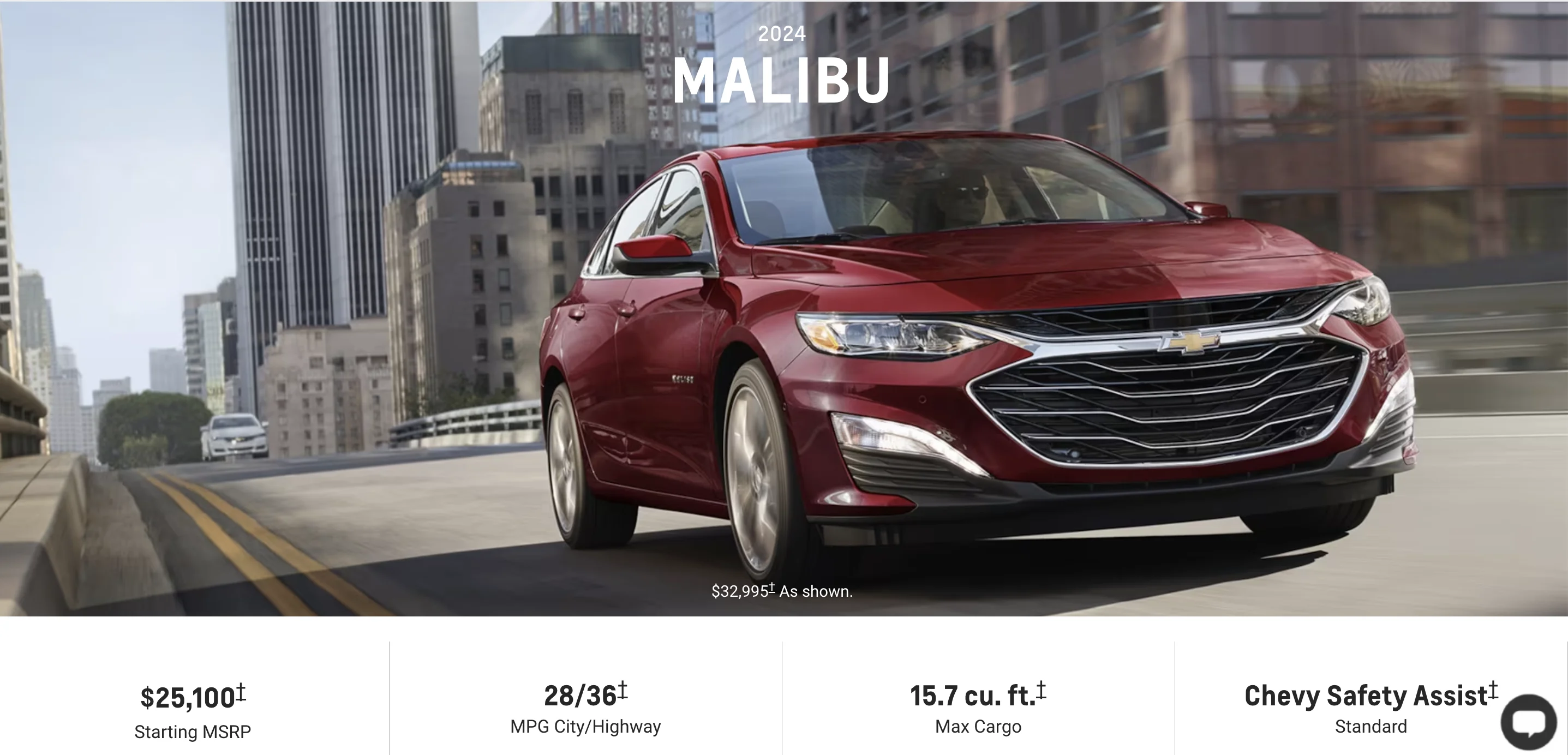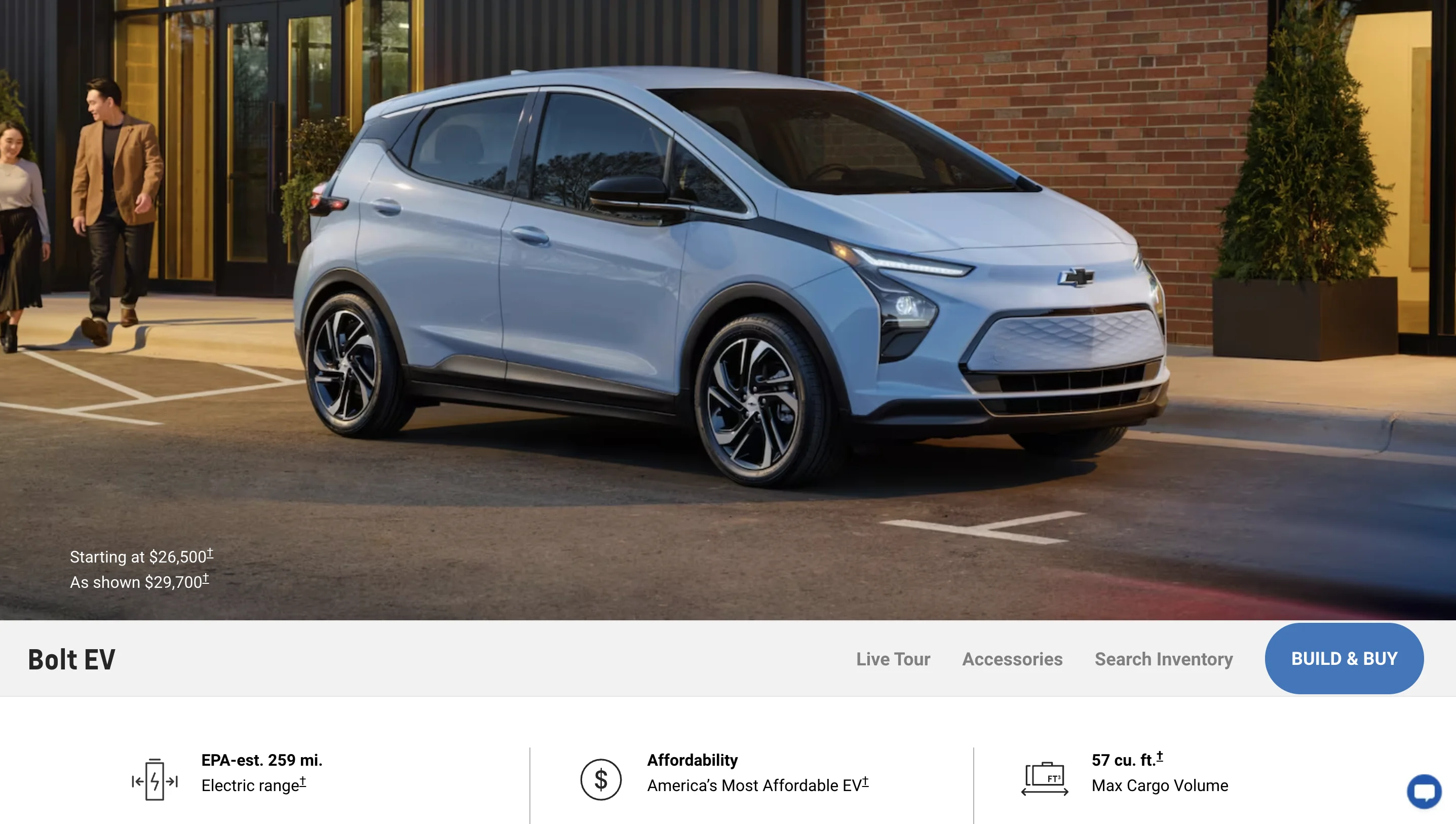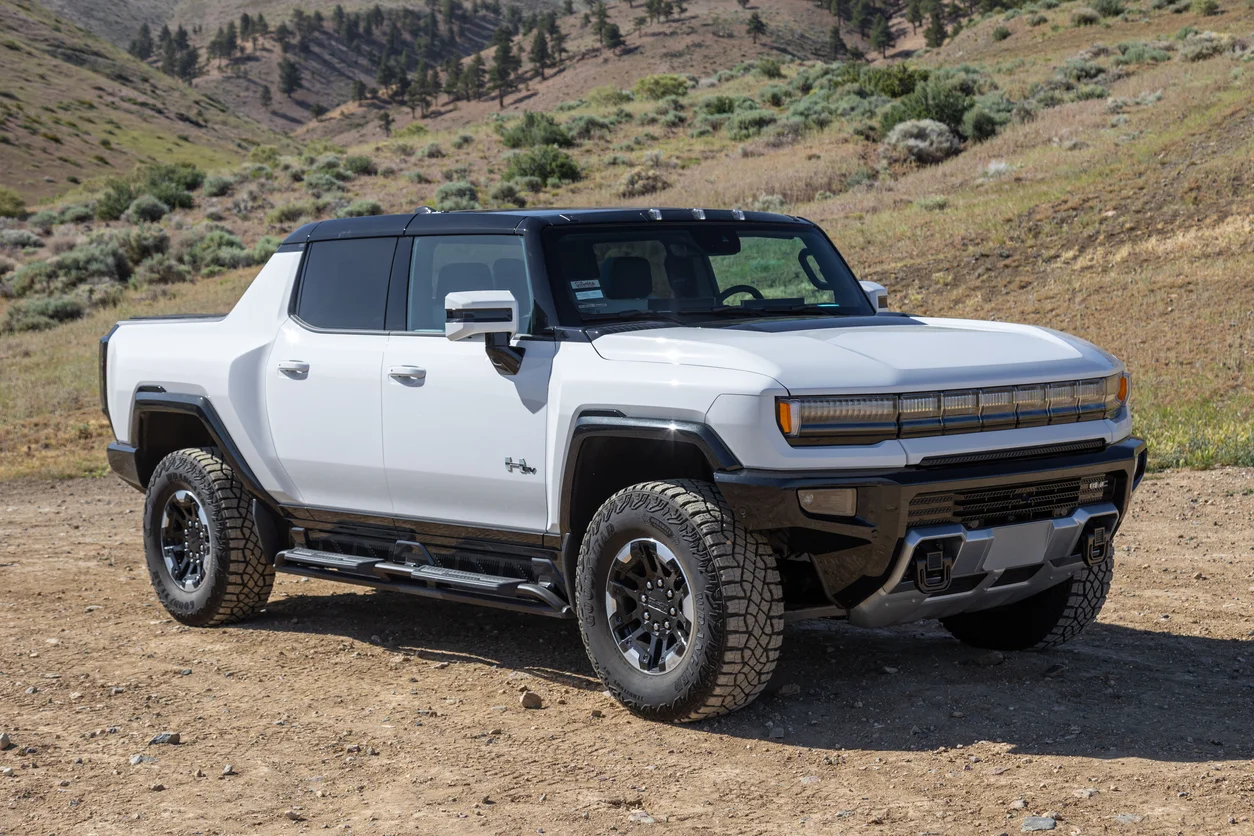ICE Vehicle Range vs. EV Range
Think back to the last time you purchased a gasoline vehicle. Did you think about the total range of the vehicle, or how far you could travel without stopping? Probably not. Prior to the rise of modern EVs, consumers were primarily concerned with fuel economy as a cost saving feature.

In advertisements for gasoline cars like the Chevrolet Malibu, fuel economy is prominently featured, but total driving range is rarely mentioned. To determine the total driving range, you'd have to find the gas tank size (often buried in technical specifications) and multiply that by the fuel economy. For example, with the Malibu's 15.8-gallon tank and 27 mpg city rating, that yields 426.6 miles of city driving range. As of 2021, the median ICE vehicle range was slightly above 400 miles, which is nearly double what the average EV could cover.

Now let's take a look at EV advertising, such as for the Chevrolet Bolt EV. Instead of listing fuel economy, the total range is prominently featured. Battery size details are often omitted, especially for vehicles with only one battery option. For vehicles that offer multiple battery sizes, such as the Volkswagen ID.4, the battery capacity is typically listed alongside the range.
Measuring EV Efficiency
In an EV, the gas tank is replaced with a battery. The obvious number to think about would be miles per charge, but it's difficult to compare efficiencies when a Nissan LEAF has a 40 kWh battery and a Tesla has 100 kWh battery. Like in a gas-powered car, efficiency needs to be measured per a standardized unit.
There are several ways to measure EV efficiency:
Miles per kWh (mi/kWh)
This is one of the most straightforward measures of EV efficiency, showing exactly how far your car travels on one kilowatt-hour of electricity. For the Bolt EV with a 65 kWh battery and 259 miles of range, the efficiency is just under 4 miles/kWh. This measurement is often displayed on the vehicle's dashboard and allows for easy calculation of expected range (battery size × miles/kWh).
kWh per 100 miles
This is a common measurement reported by the EPA. It is standardized at 100 miles and describes how many kWh of energy will be consumed to travel this distance. For example, a vehicle rated at 24 kWh/100 miles means it requires 24 kilowatt-hours to travel 100 miles. If the battery in the car you’re looking at is 50 kWh, it’s not hard to understand that you should get around 200 miles per charge.
MPGe (Miles Per Gallon Equivalent)
MPGe was created to allow shoppers to compare vehicle fuel efficiency across fuel types. It uses the standard conversion of 33.7 kWh per gallon of gasoline (the energy equivalent). For the Bolt EV, the MPGe is 131 for city driving and 109 for highway driving, with a combined rating of 120.
The relationship between MPGe and miles per kWh is:
- 131 MPGe: 131 ÷ 33.7 = 3.89 miles/kWh
- 109 MPGe: 109 ÷ 33.7 = 3.23 miles/kWh
- 120 MPGe: 120 ÷ 33.7 = 3.56 miles/kWh
The main reason that MPGe is useful is to showcase just how efficient EVs really are. The average EV efficiency is 100 MPGe, which is far more than the 25-35 MPG that most gas cars get.
EPA Testing for Efficiency
The EPA (Environmental Protection Agency) is responsible for measuring and reporting the efficiency of all consumer vehicles on the road in the US. It uses five road tests that simulate different driving conditions and then combines them to get efficiency values.
Generally, MPG, MPGe, and electric range are tested according to EPA protocol by the car manufacturer and then reported to the agency. A percentage of the reported values are verified by the EPA, which explains occasional controversies around manufacturer-stated ranges versus independently reviewed ranges.
It's important to note that EPA testing follows a specific protocol that may not match your driving style. Manufacturers often include a disclaimer stating that actual range can vary significantly based on factors like ambient temperature, terrain, battery age and condition, loading, and how you use and maintain your vehicle.
Why EVs Are More Efficient Than Gas Cars
Electric vehicles are inherently more efficient than internal combustion engines for several fundamental reasons:
Thermodynamic Advantages
The second law of thermodynamics states that heat cannot be converted entirely to mechanical energy, and some amount of waste heat will always be lost to the environment. In other words, moving parts mean lower efficiency. Modern automobile engines have hundreds or even thousands of moving parts, creating friction and heat waste. The highest possible thermal efficiency for a combustion engine is 35-40%.
Vehicle efficiency is further compromised by drivetrain losses through components such as the clutch, gearbox, propeller shaft, differential, and drive shafts – all of which have moving parts. Two-wheel drive vehicles typically experience drivetrain losses of around 15%, with higher losses in all-wheel drive vehicles. In total, only 15-30% of the energy from gasoline is actually translated to the wheels.
What about EVs? Electric motors, by contrast, can convert roughly 80% of electrical energy into mechanical energy. This dramatic difference occurs because electric motors have far fewer moving parts—sometimes as few as 20—resulting in less friction and heat generation.
.jpg)
Regenerative Braking
In addition to their improved baseline efficiency, EVs can recapture lost energy through regenerative braking. When a conventional vehicle brakes, it converts mechanical energy into heat that dissipates into the atmosphere. With regenerative braking, the electric motor behaves like a generator during deceleration, converting kinetic energy back into electricity to charge the battery. This feature alone can significantly improve efficiency, especially in city driving with frequent stops.
What Affects EV Efficiency?
Many factors affecting EV efficiency are shared with ICE vehicles, but with some key differences:

Aerodynamics
Aerodynamics significantly impact the efficiency of all vehicles, due to factors called downforce and drag. Have you ever put your hand out of a car window on the highway? The force you feel pushing your hand backwards is a force called air resistance, or drag. Drag counteracts forward movement and requires more power to maintain speed, particularly at higher velocities. Studies indicate that aerodynamic drag may contribute up to 50% of a vehicle's total fuel consumption at highway speeds. A 10% reduction in aerodynamic drag can improve highway fuel economy by roughly 5%.
Aerodynamics are arguably more important for EVs than for gas vehicles. Since electric motors are already highly efficient with limited room for improvement, gains must come from other areas like reducing air resistance. Additionally, while gasoline vehicles achieve better efficiency at constant moderate speeds despite increased drag, EVs become exponentially less efficient at high speeds as drag increases with the square of velocity.
Tires
Tires present unique challenges for EVs. Electric vehicles are significantly heavier than comparable gasoline vehicles due to their large batteries, and electric motors generate substantial torque that puts additional strain on tires. Therefore, EV tires need to carry heavier loads and withstand high torque while maintaining comfort, minimal rolling resistance, and appropriate traction.
Pirelli estimates that tires influence an EV's range by 20-40%, compared to 15-20% for ICE vehicles. Similarly, Michelin claims that while about 5% of an ICE vehicle's energy goes to the tires, this figure rises to approximately 16% for EVs. Many manufacturers now offer EV-specific tires designed to decrease rolling resistance while maintaining safety.
Climate Control and Auxiliary Systems
In most EVs, the high-voltage battery powers climate control, lights, and on-board systems. This means that a portion of your "fuel" is used to support vehicle functions unrelated to propulsion. In an ICE vehicle, gasoline moves the vehicle while the 12V battery operates auxiliary systems, making fuel efficiency more directly proportional to miles driven.
Temperature
Battery chemistry is less efficient in cold temperatures, reducing the energy available for driving. Additionally, energy is diverted to heat the cabin and sometimes the battery itself. Cold-weather driving conditions like snow and slush also create more rolling resistance, a sort of friction that is related to tires. The average range reduction at freezing temperatures is 20%, with that number getting higher the colder it gets.

Terrain
Notice how walking uphill is more exhausting than walking downhill, or on a flat road? It's the same for cars (thanks physics). Both EVs and gas powered cars will use more energy going uphill. The cool thing is that going downhill, regenerative braking can even add energy back into the battery!
City vs. Highway Efficiency
All of the factors above affect both gas and electric cars, even though the magnitude of their effects may be different. But here is where gas and electric cars diverge.
Electric vehicles typically achieve their highest efficiency in city driving environments, which is the opposite pattern of traditional combustion engines. This urban advantage stems primarily from regenerative braking, which recaptures energy normally lost during deceleration. In stop-and-go traffic, EVs can recover up to 70% of this energy, essentially transforming traffic lights and congestion into charging opportunities.
Additionally, city driving involves lower speeds where aerodynamic drag remains minimal. The combination of frequent regenerative braking opportunities and reduced wind resistance creates ideal conditions for EV efficiency, allowing many models to achieve 15-25% better energy economy in city settings compared to highway driving.
.jpg)
Highway driving presents an efficiency challenge for electric vehicles. The primary culprit is aerodynamic drag, which increases exponentially with speed—doubling your speed quadruples the air resistance. At highway velocities (65+ mph), EVs must overcome significant drag forces that rapidly deplete battery reserves. Additionally, regenerative braking provides minimal benefit during sustained high-speed travel where braking is infrequent. These factors combine to reduce highway efficiency by approximately 10-30% compared to city driving for most EVs, though this varies significantly based on vehicle aerodynamics.

What Information is Actually Important?
Arguably, range is the most important detail as it will dictate the functionality of the vehicle. For gasoline vehicles, the average gas tank is 12-15 gallons, with the smallest gas tanks being in the 8-10 gallon range. The Scion iQ, for example, has a gas tank of only 8.5 gallons. Given the EPA combined MPG of 37, the vehicle can still travel nearly 315 miles per tank, significantly more than the majority of EVs on the market today.
EVs, on the other hand, vary vastly in battery size and capabilities. Searching for “best EVs” often yields a list of vehicles sorted by highest range, rather than best efficiency. However, Recurrent is a great source for the Most Efficient EVs of 2025.
Let’s look at a few examples that vary in battery size and efficiency.
- Mazda MX-30
92 MPGe combined, 35.5 kWh battery
Here’s where EVs get tricky. Although 92 miles per gallon (equivalent) sounds great, this particular EV has a pretty small battery, and thus only has a range of about 100 miles. Regardless how fuel efficient the vehicle is, the range is far too low for most consumers, based on the relatively small battery. In this case, reporting the range is primary, and the efficiency is secondary.
- Hyundai Ioniq 6
140 MPGe combined, 77.4 kWh battery (long range RWD, SE trim)
121 MPGe combined, 77.4 kWh battery (long range RWD, SEL trim)
In this particular case, the efficiency is best in class. For the long range model, the car can be optioned with the SE or SEL trim. For the SE trim, the efficiency and battery size yields a range of nearly 360 miles. The SEL trim, on the other hand, has an estimated range of only 305 miles, despite having an identical battery size. In this case, knowing the efficiency provides some perspective. Interestingly, the major difference between the two trims is the increase in wheel size from 18-inch wheels to 20-inch wheels.
An 11% increase in wheel size results in a 14% decrease in efficiency.

- Hummer EV
53 MPGe combined, 212 kWh battery
Hummers are notorious for two things: huge batteries and being inefficient. The new Hummer EV is no exception. While its range seems impressive at 329 miles, it actually has the largest battery of any EV on the market - a battery that could take much smaller and more efficient EVs much farther. If range is the only thing you’re concerned about, the Hummer EV is a good choice relative to the average EV. However, if you’re factoring in cost to charge, time required for charging, and efficiency, this vehicle makes a very poor choice.

Range and efficiency
If you multiply an EV's efficiency by its battery size, you will get the range. This means that your range fluctuates as your efficiency changes. Going uphill? Lower range. Using a lot of regenerative braking? Higher range.
It’s easy to see the relationship between MPGe and miles per kWh:
131 MPGe = 3.89 miles/kWh -> range 252 miles (3.89 mi/kWh x 65 kWh)
109 MPGe = 3.23 miles/kWh -> range 210 miles
120 MPGe = 3.56 miles/kWH -> range 231 miles
So why are we so obsessed with EV range? To put it simply—conditioning and routine. The average consumer has been driving gasoline vehicles with ranges over 300 miles for decades, with little concern about gas station availability. Public EV chargers, however, can be limited and reliability varies.
It's worth remembering that the average driver travels only about 35 miles per day. For older EVs or those with limited range, having access to home charging, reliable public charging, or workplace charging is essential. Such vehicles may not be ideal for road trips, but for daily use, they're more than adequate.
Why Efficiency Matters
You might wonder: if EVs are inherently more efficient and produce fewer direct emissions, why should we care about efficiency differences between them? There are several important considerations:
- Resource Conservation: EVs require critical minerals that must be mined from the earth. More efficient EVs can achieve longer ranges with smaller batteries, reducing resource consumption.
- Grid Impact: Most EVs charge from the existing electric grid, which faces challenges from natural disasters and climate change. Higher efficiency reduces the strain on electrical infrastructure.
- Cost Effectiveness: More efficient EVs cost less to operate and can achieve better range with the same battery size, making them more attractive to consumers.
- Environmental Impact: In regions heavily dependent on fossil fuels for electricity generation, more efficient EVs will have a lower carbon footprint.
Conclusion
Efficiency and range are intricately linked, whether discussing EVs or gasoline vehicles. Higher efficiency does not necessarily mean longer range when comparing different vehicles. Some EVs, like the Nissan Leaf, are considered very efficient but have limited range due to smaller batteries. Others, like the Rivian R1T, are less efficient but can still travel over 300 miles on a charge thanks to larger batteries.
While MPGe is useful for comparing efficiencies between ICE vehicles and EVs, miles per kWh provides a more intuitive measurement for EV owners, allowing for easy range calculations and direct efficiency comparisons between electric models.
As the EV market matures and charging infrastructure expands, we may see consumer focus shift from maximum range toward overall efficiency—prioritizing vehicles that travel farther using less energy and fewer resources, rather than simply those with the biggest batteries and longest range figures.



